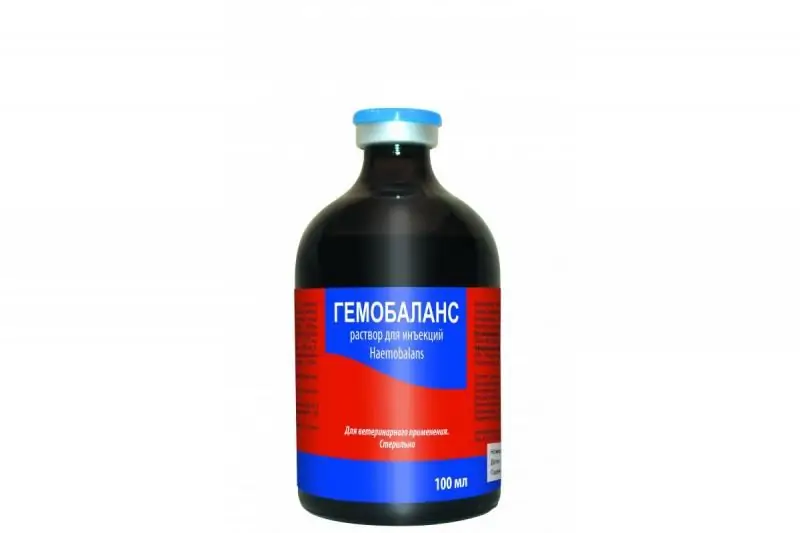
Table of contents:
- The drug Hemobalance for cats: indications for use and effect
- Composition and release form of the drug Hemobalance
- The mechanism of action of the drug Hemobalance
- Indications for use
- Rules for taking Hemobalance
- Contraindications and side effects
- Interaction of Hemobalance with other drugs
- Storage conditions and shelf life of Hemobalance
- Cost and analogues
- Author Bailey Albertson [email protected].
- Public 2023-12-17 12:53.
- Last modified 2025-01-23 12:41.
The drug Hemobalance for cats: indications for use and effect

In everyday life, cats that receive a quality balanced diet have enough nutrients contained in it. But in cases where the animal is under stress or its body is weakened, an additional source of vitamins and minerals is needed. A good choice in such situations would be Hemobalance - a universal multivitamin complex with added amino acids. The drug is prescribed during the recovery period after surgery, as a prophylaxis during vaccinations, exhibitions, travel, and also as an immunostimulant for animals with weakened immunity.
Content
- 1 Composition and release form of the drug Hemobalance
- 2 The mechanism of action of the drug Hemobalance
- 3 Indications for use
-
4 Rules for taking Hemobalance
-
4.1 Features of using Hemobalance in kittens and pregnant cats
4.1.1 Video: Veterinarian explains the rules for setting intramuscular injections
-
- 5 Contraindications and side effects
- 6 Interaction of Hemobalance with other drugs
- 7 Storage conditions and shelf life of Hemobalance
-
8 Cost and analogues
8.1 Table: comparison of multivitamin complexes in composition, indications and price
Composition and release form of the drug Hemobalance
Hemobalance is available in the form of a solution in dark glass vials with a volume of 5, 10, 100 and 500 ml.
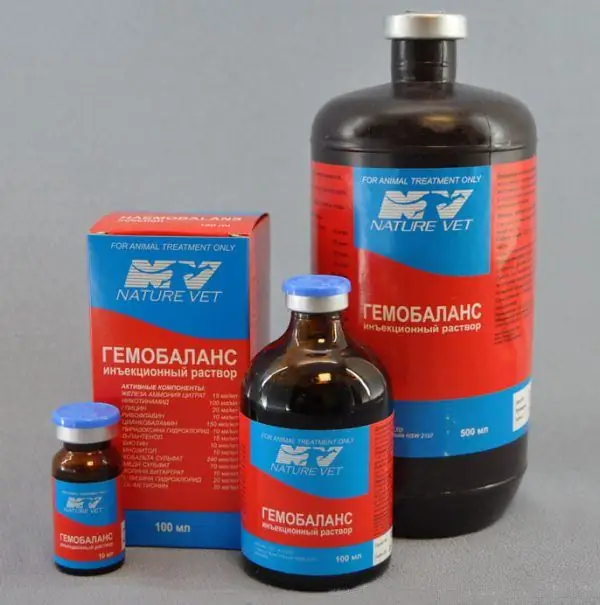
Hemobalance is available in a dosage of 5, 10, 100 and 500 ml
It is a complex preparation that contains amino acids, vitamins and minerals:
- iron ammonium citrate, which is necessary for the synthesis of hemoglobin, a sufficient amount prevents the development of anemia;
- nicotinamide (or vitamin PP), which is involved in protein and carbohydrate metabolism. With a deficiency of this vitamin in cats, the mucous membranes of the mouth can be affected, stomatitis develop, the skin peels off, and the hair falls out. In severe hypovitaminosis, the animal suffers from convulsions and paralysis;
- glycine is an inhibitory amino acid that acts as a mild sedative in cats during periods of stress or heat. As part of a comprehensive treatment, glycine contributes to the nutrition of brain tissues, for example, after a stroke;
- riboflavin (vitamin B 2) has a wide spectrum of action - it regulates the function of the retina and prevents inflammation of its mucous membranes, normalizes digestion, has a positive effect on the reproductive system;
- cyanocobalamin (vitamin B 12) is necessary for the normal functioning of the hematopoietic system - it affects the synthesis of red blood cells and the maintenance of normal hemoglobin levels. It also improves the functioning of the liver and nervous system. In addition, cyanocobalomin is a necessary component of the immune response, activating the formation of antibodies. Isolated cyanocobalomin is often administered before surgery to improve blood clotting and after surgery to accelerate the regeneration processes and increase the hemoglobin level;
- pyridoxine hydrochloride (a derivative of vitamin B 6) regulates the functioning of the central and peripheral nervous system, participates in the exchange of amino acids and reduces capillary permeability, which plays an important role in preventing the development of edema in case of allergies. Hypovitaminosis B 6 leads to anemia, seizures, atrophy of the immune system and, accordingly, a strong decrease in immunity;
- D-panthenol is a derivative of pantothenic acid, it accelerates the regeneration of the skin and mucous membranes and normalizes the intestines. The most popular panthenol is in the form of ointments and sprays, but when taken orally, it is also highly effective.
- biotin - a vitamin that participates in the work of muscles and the nervous system, and also has a beneficial effect on the coat, gives it shine and density;
- inositol also affects the skin and coat, but its main function is to normalize fat metabolism and maintain a healthy weight;
- cobalt sulfate is involved in blood formation, hemoglobin production and regulation of the thyroid gland;
- copper sulfate is mainly used to combat helminthic invasions;
- choline bitartrate as a component of acetylcholine is involved in the transmission of nerve impulses, providing the heart, liver and skeletal muscles with energy;
- L-lysine hydrochloride promotes the absorption of phosphorus and calcium, which are necessary for the health of the skeletal system, and also has a positive effect on the state of the reproductive system;
- DL-methionine is an antioxidant that protects the liver from damage and also aids in the absorption of nutrients.
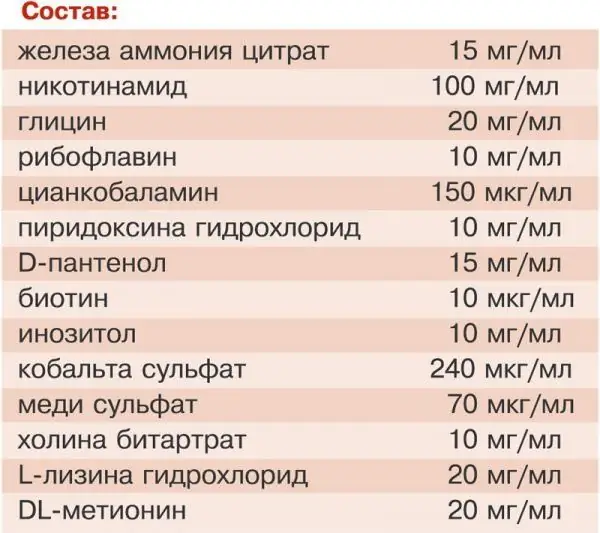
Hemobalance contains vitamins, amino acids and minerals
The mechanism of action of the drug Hemobalance
The complex of active substances contained in Hemobalance is aimed at maintaining all body systems and protecting the internal organs. This is achieved through the following mechanisms of action:
- normalization of protein, carbohydrate and fat metabolism;
- influence on hematopoiesis, activation of the hematopoiesis process and increase in hemoglobin levels;
- increased energy metabolism in cells, increased muscle work;
- strengthening immunity;
- positive impact on the reproductive system;
- acceleration of metabolism.
Indications for use
Hemobalance has a wide spectrum of action, therefore, there are many indications for its use. The drug is effective both for the prevention of diseases and for their treatment.
Indications:
- prevention and treatment of hypovitaminosis;
- stressful situations (exhibitions, moving);
- preparation for surgery and the postoperative period;
- allergy;
- poisoning;
- viral infections and helminthic invasions (as part of complex therapy);
- liver pathology;
- exhaustion;
- anemia and blood loss;
- ovarian hypofunction;
- dermatological diseases;
- bronchitis and pneumonia;
- kidney disease;
- recovery from injuries;
- pregnancy.
Rules for taking Hemobalance
Hemobalance is administered in the form of intramuscular injections or intravenous drip, diluted in physiological solution. For prophylaxis, 1-2 injections are given per week, in the treatment of 2-3 injections, depending on the disease and other medications received by the cat.
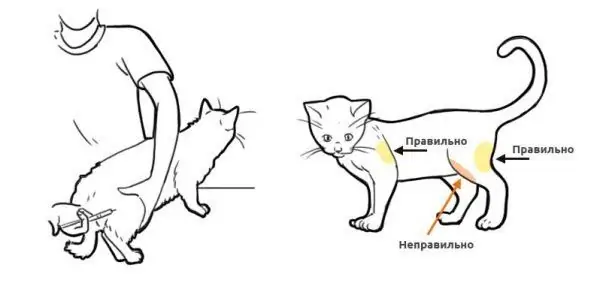
Hemobalance injection is placed in the thigh muscle
If the owner decides to give the pet Hemobalance to prevent stress during an exhibition or moving, then one injection is given a day before the event. If the stress is going to be prolonged, then you can give 4 injections: 8, 6, 4 and 1 day before the event.
A single dosage is calculated depending on body weight. For animals weighing less than 5 kg, the dose of the drug will be 0.25 ml; cats weighing from 5 to 15 kg receive 0.5 ml of Hemobalance.
Hemobalance injections are given within 7-10 days.
Peculiarities of using Hemobalance in kittens and pregnant cats
Hemobalance is beneficial for pregnant cats, as it helps to cope with toxicosis and to bear healthy kittens, forming a strong skeletal system in them and preventing rickets. During pregnancy and in the postpartum period, the drug is given according to the standard scheme. Injections of Hemobalance are also recommended for kittens that are lagging behind in development: with an insulin syringe into the thigh muscle, 0.25 ml once a day.
Video: a veterinarian explains the rules for setting intramuscular injections
Contraindications and side effects
Hemobalance is a multivitamin complex, so it is safe to give it to animals of any age. The only side effect may be an allergic reaction in hypersensitive cats, resulting in facial swelling, shortness of breath, and lethargy. It is necessary to stop this complication with antihistamines - immediately give an injection of Diphenhydramine or Suprastin intramuscularly. It is advisable to immediately refer the animal to a veterinarian who can give an injection of glucocorticosteroids in case of anaphylactic shock.
Interaction of Hemobalance with other drugs
Hemobalance has a strengthening effect on the body, stimulates the immune system, so it is not only not prohibited, but it is often recommended to be taken together with other drugs.
Veterinarians often recommend supplementing antibacterial and antiviral therapy with Hemobalance; you can also give injections of this drug during the period of vaccinations and taking anthelmintic tablets.
It is forbidden to combine Hemobalance injections with the intake of other iron-containing drugs
Storage conditions and shelf life of Hemobalance
It is necessary to store Hemobalance in a cool dry place at a temperature of 4 to 25 degrees (when frozen, the beneficial properties are completely lost). Although the bottle is made of dark glass, it is better to protect the drug from direct sunlight. If these rules are observed, the shelf life of Hemobalance is six months.
There are several signs that the drug is spoiled and should not be consumed:
- precipitation;
- the appearance of impurities;
- discoloration of the liquid;
- clouding of the contents of the bottle.
Cost and analogues
Hemobalance has practically no analogues in terms of affecting the circulatory system. However, there are several multivitamin complexes, which are also available in the form of an injection solution, to strengthen the animal's body and support it during stress.
Table: comparison of multivitamin complexes by composition, indications and price
| Drug name | Structure | Indications | Contraindications | The cost |
| Hemobalance |
|
|
no | 250-280 rub for 5 ml |
| Dufalight |
|
|
no | 1000 rub for 500 ml |
| Wittree-1 | Vitamins A, E, D3 |
Diseases of the bone and nervous system |
no | 150-200 rubles for 20 ml |
| Gamavit | A complex of amino acids, vitamins, trace elements |
|
no | 160-200 rubles for 10 ml |
Hemobalance is practically a universal drug, it has many indications and practically does not cause side effects. Its downside is that the main method of application is injections, which some cat owners are afraid to do themselves, besides, the injections are quite painful. Nevertheless, its high efficacy, wide spectrum of action and absence of contraindications make Hemobalance an ideal choice for cat owners.
Recommended:
Catosal For Cats: Instructions For Use In Veterinary Medicine, Indications And Contraindications, Dosage, Reviews And Analogues
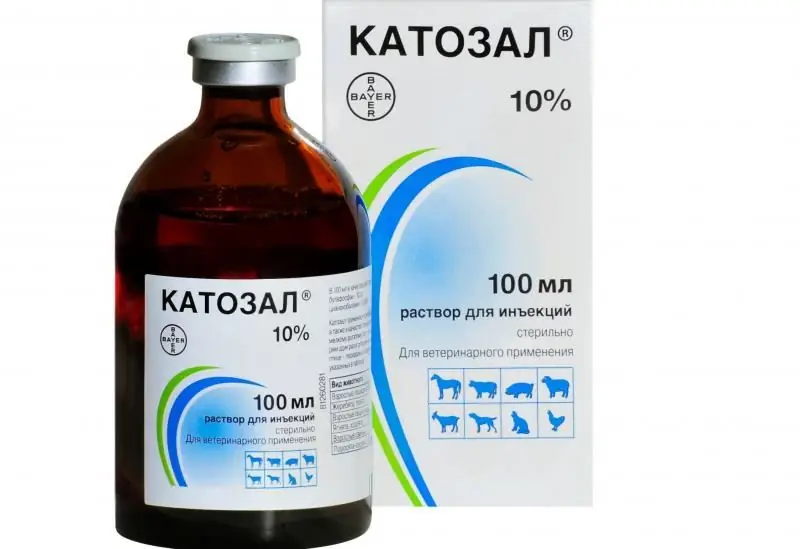
What is the drug Catosal used for in cats? What effect does the product have? Are there any contraindications and side effects? Reviews about the drug
Execan For Cats: Instructions For Use, Dosage Of The Drug, Indications And Contraindications, Side Effects, Analogues, Reviews

Composition and release form of the drug Execan, indications, contraindications, dosage, storage, comparison with analogues. Reviews
Amoxicillin For Cats: Instructions For Using The Antibiotic, Dosage Form, Contraindications And Side Effects, Dosage, Reviews
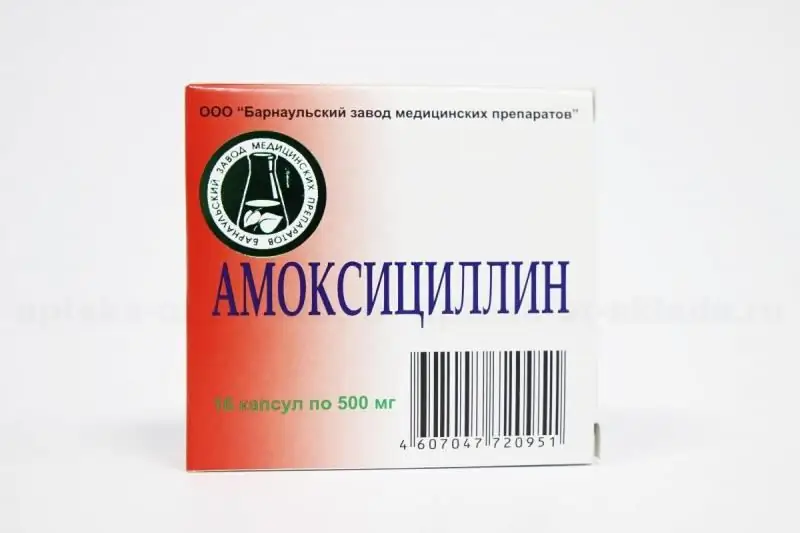
When Amoxicillin is used in cats, what effect does it have, are there any contraindications and side effects. Reviews of cat owners and veterinarians
Gestrenol For Cats: Instructions For Use, Drops And Tablets, Indications And Contraindications, Reviews, Cost And Analogues
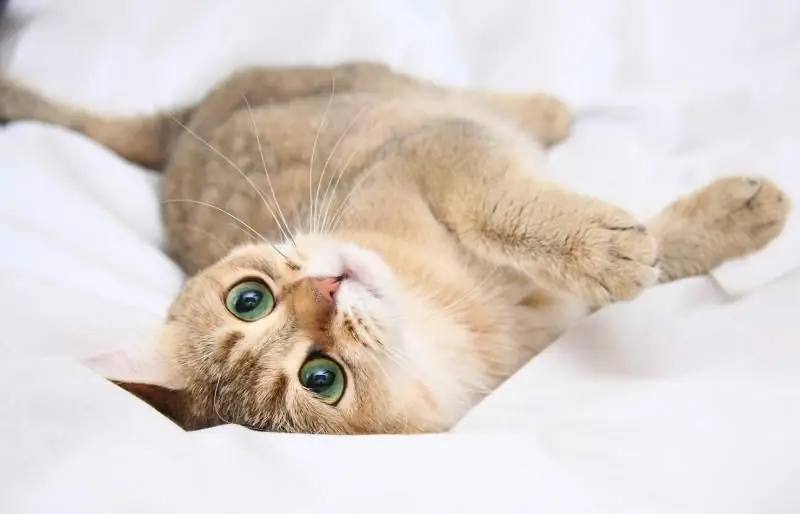
What is Gestrenol used for? Composition and form of release. Contraindications, side effects. Interaction with medications. Drug analogues. Reviews
Sex Barrier For Cats And Cats: Composition And Mechanism Of Action Of Antisex, Contraindications And Side Effects, Cost, Analogues, Reviews
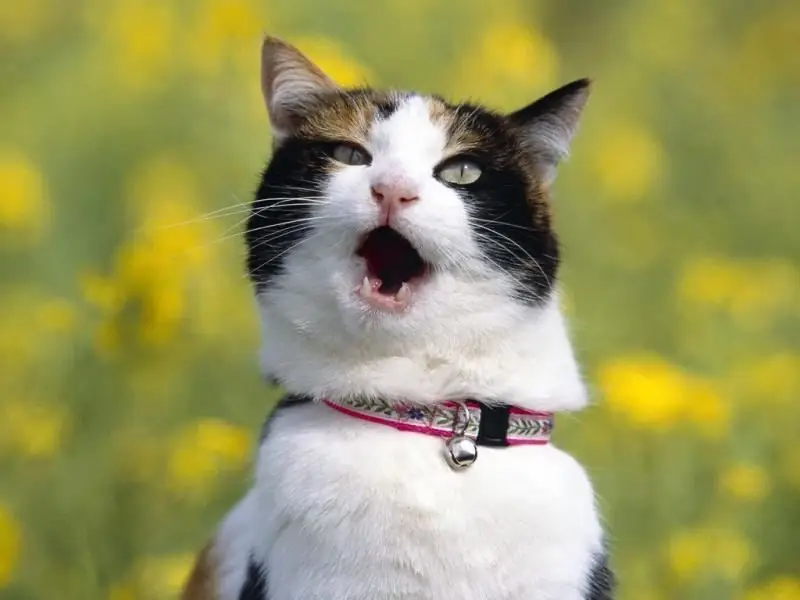
Sex barrier against sexual hunting in cats and cats: release forms, composition, mechanism of action, use, analogs, reviews of owners and veterinarians
